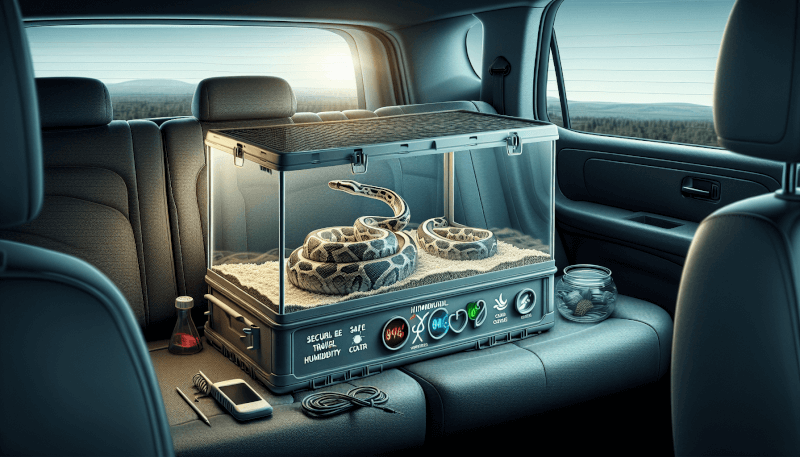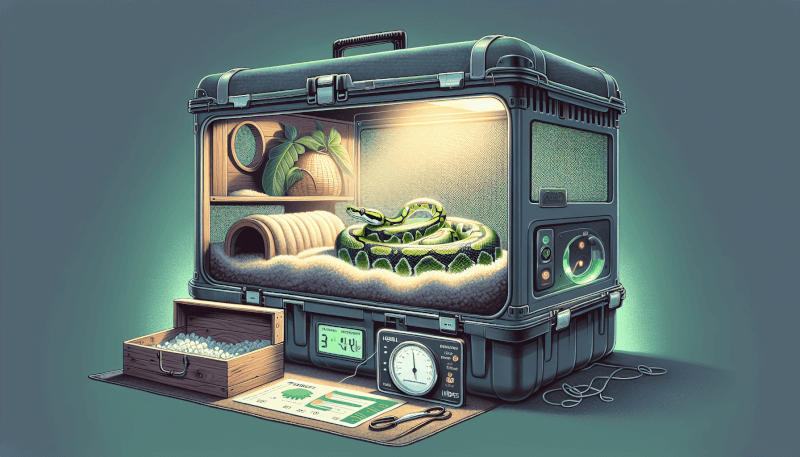Planning a trip with your snake can be both exciting and daunting, but with the right setup, you can ensure a secure and stress-free travel experience for your scaly companion. Whether you’re going to the vet, moving to a new home, or simply taking a road trip, there are a few essential steps you need to follow to create a comfortable environment that will minimize your snake’s stress levels and keep them safe throughout the journey. From choosing the right carrier to providing a familiar habitat, this article will guide you through the process of creating a travel setup that will keep your snake happy and secure.

Choosing the Right Travel Container
Size and Comfort
When choosing a travel container for your snake, it is essential to consider the size and comfort of the enclosure. The enclosure should be spacious enough for your snake to move around comfortably but not too large that it becomes difficult to secure and handle during travel. A good rule of thumb is to provide at least two-thirds of your snake’s length in enclosure length to ensure they have enough space to stretch out. Additionally, be mindful of the height of the container to prevent escape attempts.
Material and Durability
The material and durability of the travel container are crucial factors to consider. Opt for containers made from sturdy materials such as plastic or glass that can withstand any bumps or jostling during transportation. Make sure the container is well-constructed and free from any cracks or breaks that could compromise your snake’s safety. Plastic containers are often preferred due to their lightweight nature, which makes them easier to carry.
Ventilation
Proper ventilation is essential to maintain a suitable environment for your snake during travel. Ensure that the travel container has adequate ventilation holes or mesh screens to allow for proper airflow. These openings will help regulate temperature and prevent the accumulation of humidity, preventing your snake from overheating or becoming uncomfortable during the journey.
Preparing the Travel Container
Cleaning and Disinfecting
Before placing your snake in the travel container, it is crucial to clean and disinfect it thoroughly. Remove any prior substrates, debris, or waste from the enclosure. Wash the container with a reptile-safe disinfectant, rinse it thoroughly, and let it dry completely. This step ensures a clean and hygienic environment for your snake during travel.
Adding Substrate
Substrate, such as paper towels or reptile-specific bedding, should be added to the travel container. This helps provide a comfortable surface for your snake to rest on during the journey. Avoid using loose substrate materials, such as sand or wood chips, as they can cause respiratory issues or become ingested by your snake.
Creating Hiding Spots
Snakes often seek shelter and security in enclosed spaces, so it is crucial to create hiding spots in the travel container. You can use simple items like cardboard tubes or small plastic containers as hiding spots for your snake. These hiding spots give your snake a sense of security during transit, reducing stress and promoting a more comfortable journey.
Temperature and Humidity
Monitoring and Regulation
Maintaining appropriate temperature and humidity levels in the travel container is essential for your snake’s well-being. Use a reliable thermometer and hygrometer to monitor the temperature and humidity inside the enclosure. Ensure that the temperature stays within the appropriate range for your snake species and that the humidity remains at an optimal level to prevent dehydration or respiratory issues.
Portable Heating Options
In colder climates or during longer journeys, it may be necessary to provide additional heat for your snake. Use portable heating devices, such as heat packs or reptile-specific heating pads, to maintain a comfortable temperature inside the travel container. Make sure to position the heating source in a way that your snake can move away from it if necessary to avoid overheating.
Managing Humidity Levels
To maintain appropriate humidity levels, you can lightly mist the inside of the travel container with water using a spray bottle. Be cautious not to make the environment excessively humid, as this can lead to respiratory problems. Monitoring humidity levels throughout the journey and making adjustments as necessary will help ensure your snake remains comfortable and hydrated.
Feeding and Watering
Pre-Travel Feeding
It is advisable to feed your snake a suitable meal a few days before travel. This allows time for digestion and prevents the risk of regurgitation during transit. Offering your snake a slightly smaller meal than usual is recommended to minimize any potential discomfort during travel.
Water Dispenser Options
Ensure that your snake has access to water throughout the journey by providing a suitable water dispenser in the travel container. Choose a spill-proof water bowl or a water bottle designed specifically for reptile enclosures. Regularly check the water dispenser to ensure water is available and fresh for your snake.
Frequency of Hydration
Monitor your snake’s hydration needs during the journey. Depending on the duration of travel, you may need to offer your snake water during stops or on a regular schedule. Observing your snake’s behavior and ensuring it stays adequately hydrated will help reduce stress and promote a healthier travel experience.

Safety Measures
Securing the Container
Safety should always be a top priority when traveling with your snake. Make sure the travel container is securely fastened and cannot be opened accidentally during transportation. Check all locks, latches, or closures to ensure they are functioning correctly. Additionally, consider using additional cable ties or straps to provide an extra layer of security.
Avoiding Rough Handling
Handling your snake gently and with care is crucial to its well-being during travel. Avoid any rough or aggressive movements that could startle or harm your snake. When carrying the travel container, keep it level and stable to prevent unnecessary jostling and stress for your snake.
Emergency Contacts and Information
Always be prepared for unexpected situations or emergencies during travel. Have emergency contact information for a reptile-savvy veterinarian readily available. Research and note down the contact details of veterinary clinics or herpetologists along your travel route. Familiarize yourself with common signs of distress or illness in snakes to recognize any potential issues promptly.
Choosing the Right Mode of Transportation
Air Travel Considerations
If you are traveling by air with your snake, it is crucial to familiarize yourself with the airline’s policies and requirements for transporting live animals. Contact the airline well in advance to inquire about any necessary documentation, container specifications, or additional fees. Follow all regulations and guidelines to ensure a smooth and stress-free journey for both you and your snake.
Road Trip Preparations
If you are embarking on a road trip with your snake, there are several preparations to consider. Ensure that your snake’s travel container is securely placed in the vehicle and won’t slide or shift during travel. Opt for a well-ventilated area that maintains a consistent temperature. Plan regular stops to check on your snake, provide hydration if necessary, and allow for bathroom breaks.
Avoiding Unnecessary Stops
Minimize unnecessary stops during your journey to reduce stress on your snake. Plan your route strategically, considering any reptile-friendly accommodations or rest areas with suitable facilities for attending to your snake’s needs. By reducing the number of stops, you can help maintain a consistent temperature and minimize the chances of accidental escape or exposure to unfamiliar or stressful environments.

Legal Requirements and Documentation
Researching Local Regulations
Before traveling with your snake, research and familiarize yourself with the local regulations and laws regarding reptile ownership and transportation at your destination. Different regions may have specific permit requirements or restrictions on certain snake species. Ensure you are compliant with all regulations to avoid any legal complications or issues while traveling.
Obtaining Necessary Permits
If your destination requires permits or documentation for traveling with a snake, ensure you obtain them well in advance. Contact the relevant local wildlife agencies or departments to inquire about the necessary permits and the application process. Apply for permits as early as possible to allow sufficient processing time, reducing any potential travel delays or complications.
Carrying Required Documents
Always carry the necessary documents and permits related to your snake during travel. Keep copies of any permits, licenses, or health certificates readily accessible in case they are requested at any point during your journey. Storing these documents in a waterproof and secure folder will help ensure they remain intact and easily accessible.
Planning for Emergencies
Finding Reptile-Savvy Veterinarians
Before embarking on your journey, research and identify reptile-savvy veterinarians along your travel route and at your destination. In case of any emergencies or unexpected health concerns, having access to professionals experienced in reptile care can be invaluable. Save their contact information in your phone or write it down for quick reference.
Carrying First Aid Kit
Prepare a reptile-specific first aid kit to have on hand during travel. Include essentials such as antiseptic solution, sterile gauze pads, adhesive bandages, and snake-friendly insect repellent. Familiarize yourself with how to administer basic first aid for snakes, such as treating minor wounds or calming methods for stress-related symptoms.
Preparing for Potential Escapes
Even with all safety measures in place, there is always a slight risk of your snake trying to escape during travel. Prepare and carry escape prevention measures, such as spare containers, escape-proof bags, or snake hooks, to safely handle your snake if an escape attempt occurs. Stay calm and act swiftly to prevent any potential harm to your snake or others.

Minimizing Travel Stress
Gradual Habituation to Container
To minimize stress during travel, slowly acclimate your snake to the travel container before the journey. Gradually introduce them to the container by placing it in their enclosure for short periods each day, gradually increasing the duration. This process helps your snake become familiar with the container, reducing anxiety and stress during travel.
Using Familiar Scents
Snakes rely heavily on their sense of smell, so using familiar scents in the travel container can provide comfort during the journey. Place a small piece of your snake’s bedding or a non-toxic item from their enclosure, such as a clean branch or hide, inside the travel container. The familiar scent will help create a sense of security, reducing stress levels.
Reducing Noise and Vibrations
Excessive noise and vibrations can be stressful for snakes. During travel, minimize these disturbances by choosing a quiet and calm environment for your snake. Avoid placing the travel container near sources of excessive noise, such as engines or loud music. Maintaining a peaceful atmosphere will help keep your snake calm and stress-free throughout the journey.
Arriving at Your Destination
Acclimation Period
Upon reaching your destination, give your snake some time to acclimate to their new surroundings. Set up their temporary enclosure in a quiet and secure area as soon as possible. Allow your snake to adjust to the new environment gradually, providing them with familiar hiding spots and a consistent temperature and humidity level.
Setting Up Temporary Enclosure
Until your snake’s permanent enclosure is ready, set up a temporary enclosure that mimics their usual environment as closely as possible. Place appropriate hiding spots, suitable substrate, and ensure the enclosure maintains the required temperature and humidity levels. This temporary setup will provide a comforting and familiar space for your snake to settle in.
Observing Snake Behavior
After setting up the temporary enclosure, closely observe your snake’s behavior for any signs of stress or health issues. Pay attention to their eating habits, movement patterns, and overall demeanor. If you notice any significant deviations from their usual behavior, consult a reptile-savvy veterinarian to ensure their well-being and address any concerns promptly.
In conclusion, ensuring a secure and stress-free travel setup for your snake requires careful planning and attention to detail. By choosing the right travel container, preparing it properly, and maintaining optimal conditions, you can provide a comfortable and safe environment for your snake during travel. Additionally, adhering to legal requirements, planning for emergencies, and minimizing stress will help make the journey a positive experience for both you and your snake. Happy travels!



